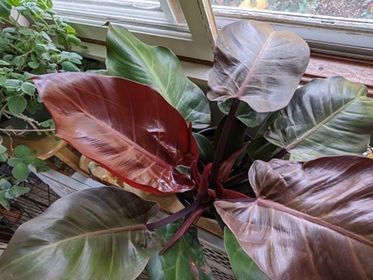Houseplant Supplemental Lighting

With the recent hard freeze, all of our houseplants are most likely currently inhabiting the indoors, whether in their final locations or scattered around the house and sunroom like mine. Every year, it seems my houseplants multiply and fill up the free space that I once had (my husband would say I have an issue; I prefer to think of it as a hobby). Unfortunately, in my house, I am limited to just a few decent windows for my collection of plants. Lack of adequate light is the most common factor limiting the growth of plants in many areas of the home. Luckily, it is easy to use supplementary lighting for plants that do not receive adequate natural light.
When adding supplemental light, the color of the light waves matters. Plants need specific wavelengths of light more than others. Leaves reflect and derive little energy from the yellow and green wavelengths of the visible spectrum. In contrast, the red and blue wavelengths of the light spectrum are the most important energy sources for plants. Plants growing outdoors, in greenhouses, or close to windows are exposed to a balance of light from the sun, including the blue and red light plants need. There are several options to provide light for plants; however, fluorescent and LED lights are the most common.
- Incandescent lightbulbs: While these may be used in lamps and light fixtures for general lighting, they are not a good option for plants because they lack the correct wavelengths and produce too much heat for plants.
- Fluorescent lightbulbs are one of the better options for providing supplemental light. They produce less heat than incandescent lightbulbs and do produce the necessary wavelengths for houseplants. Grow light bulbs are not a requirement for house plants; cool and warm light bulbs provide the needed wavelengths of light. The bulbs are available in several different lengths.
- Light-emitting diodes (LEDs) represent plants' newest source of supplemental light. They are very energy-efficient and very long-lived. Be sure to purchase LED fixtures or bulbs with red and blue wavelengths, as general LEDs usually do not. They emit very little heat and require no ballasts or reflectors. With LED lights, you get what you pay for; cheaper lights have a shorter lifespan and may not provide the correct light lengths. LEDs come in various shapes, styles, and sizes, making the bulb option perfect for use in various fixtures, or you can use the LED fixtures themselves.
Unfortunately, you can’t put the light fixtures on the ceiling and have enough light for house plants. Most plants should be located with the tips of the plants 6 to 12 inches from the light source. Light intensity drops rapidly as the distance from the light bulbs or tubes increases. Fluorescent tubes do not produce as much light at the ends as they do in the center, so the brightest spot under a fluorescent fixture is directly beneath the center of the tubes. The light fixtures' position should be adjustable to keep the distance between the light and the plant constant. One option is to hang the fixture on chains with S-hooks for easy adjustment. When plants do not receive any light from windows, the lights should run approximately 16 to 18 hours daily. If some additional light is received, 12 to 14 hours each day may be adequate. Lights should be on at the same time that plants receive window light.

Have questions? Contact our office where our Horticulture Extension Agent will assist you with questions.
Phone: (316) 321-9660
Email: callae@ksu.edu